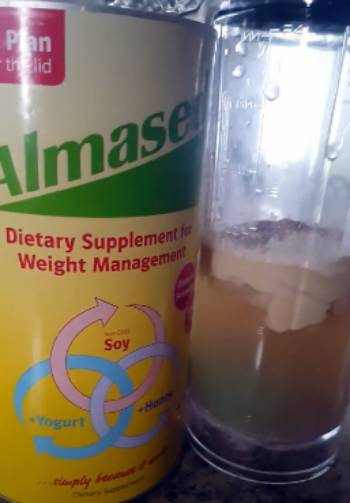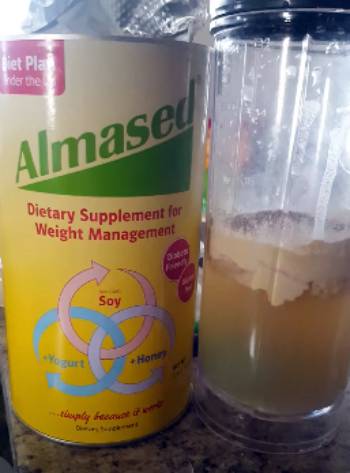I’ve tried countless diets, but Almased’s meal replacement shake has been a game-changer. This soy, yogurt, and honey blend suppresses appetite, boosts energy, and supports weight loss without artificial junk. After shedding pounds and feeling more vibrant, I’m hooked. If you’re tired of restrictive diets that leave you hungry, Almased is worth a shot. Let’s explore my journey, the pros and cons, how it stacks up against other brands, and tips to keep the weight off for good.
My Experience with Almased

Two months ago, I was fed up with my sluggish energy and stubborn weight. I’d heard about Almased, a German meal replacement shake, and its promises of metabolism boosting and appetite control. Skeptical but desperate, I ordered a can. The instructions were simple: mix 8 tablespoons with 10-12 ounces of water, skim milk, or almond milk. I started with two shakes daily, replacing breakfast and dinner, and ate a veggie-heavy lunch.
The taste? Not bad—kind of malty, like a subtle Horlicks. I jazzed it up with cinnamon and a drop of vanilla extract, which made it feel like a treat. On day one, I was surprised by how full I felt. No mid-morning snack cravings, just steady energy. By day three, I’d lost 2 pounds, likely water weight, but it was motivating. I added crushed ice to my shakes, sipping them slowly at work to stretch the satisfaction.
After a week, I noticed my jeans felt looser, and I had more pep for my evening walks. I experimented with veggie broth as a snack, tweaking it with low-sodium V8 for flavor. By week four, I’d dropped 8 pounds. The liquid-heavy diet wasn’t always easy—hunger felt different, less urgent—but drinking tons of water helped. I also added a fiber supplement to keep things moving. Almased wasn’t just about weight loss; I felt clearer, less bloated, and my Crohn’s-related stomach issues didn’t flare up. It’s now a staple, and I’m down 12 pounds, aiming for more.
Maintenance Tips for Sustained Weight Loss

- Stay Hydrated: Drinking plenty of water is crucial when using Almased. I aim for 80 ounces daily to support digestion and keep hunger in check. Adding lemon or cucumber makes it more enjoyable, and hydration enhances the shake’s effects, helping you feel lighter and more energized.
- Incorporate Exercise: Movement is key to maintaining weight loss. I walk 30 minutes daily and add yoga twice a week to keep my metabolism active. Even light activity like stretching or dancing helps burn calories and complements Almased’s fat-burning effects, ensuring long-term results.
- Eat Nutrient-Dense Meals: For your solid meal, focus on veggies, lean proteins, and healthy fats. I love a big salad with chicken or fish, dressed with olive oil. Avoiding processed carbs and sugars keeps my insulin stable, aligning with Almased’s low-glycemic approach for sustained weight control.
- Add Fiber to Your Diet: Since Almased lacks fiber, I take a daily fiber supplement or eat high-fiber foods like chia seeds or broccoli. This keeps me full and supports digestion, preventing bloating or irregularity. It’s a small tweak that makes a big difference on this diet.
- Plan for Long-Term Use: Almased works best as a lifestyle, not a quick fix. I keep one shake daily, usually for breakfast, to maintain my weight. This habit helps me control portions and avoid overeating, making it easier to stay on track without feeling deprived.
The Pros and Cons of Almased

Pros:
Almased has some serious strengths that make it a standout in the crowded world of meal replacements.
- High-Quality Ingredients: The blend of soy protein, yogurt, and honey is simple yet effective. It’s non-GMO, gluten-free, and free from artificial flavors, sugars, or preservatives. I love that it’s a natural formula, giving me confidence I’m not filling my body with synthetic junk while supporting my weight loss goals.
- Appetite Suppression: This shake keeps hunger at bay for hours. With 27 grams of protein per serving, it curbs cravings and sugar spikes, making it easier to stick to a calorie deficit. I found myself thinking less about food, which was a relief after years of battling snack urges.
- Energy Boost: Unlike crash diets that left me drained, Almased gave me steady energy. The low-glycemic formula stabilized my blood sugar, so I could power through work and still have juice for evening activities. It’s like my body was running more efficiently.
- Versatile and Customizable: You can mix Almased with water, milk, or almond milk and add flavors like cocoa or berries. I loved experimenting with cinnamon or crushed ice for a frosty shake. This flexibility kept the diet from feeling monotonous, which is key for long-term success.
Cons:
No product is flawless, and Almased has a few drawbacks to consider.
- Taste Takes Adjustment: The malty flavor isn’t for everyone, especially if you’re expecting a sugary milkshake. I got used to it, but some might find it bland or chalky. Adding flavors helps, but it’s not a gourmet experience out of the can.
- Pricey Commitment: At $30-$40 per 17.6-ounce can, Almased isn’t cheap. Each can lasts about four days if you’re doing two shakes daily, so costs add up. While it’s cheaper than some specialty diet foods, budget-conscious folks might flinch at the ongoing expense.
- Limited Fiber Content: Almased has almost no fiber, which surprised me. Without enough fiber, you might feel less full or face digestive issues. I had to add a fiber supplement, which worked but added to the cost and hassle.
- Strict Regimen Required: To see results, you need to follow Almased’s plan diligently—replacing meals and limiting calories. If you’re not ready for a liquid-heavy diet or can’t stick to the structure, results may stall. I found it doable, but it’s not for everyone.
Also Read: My Experience With Unicity Balance Weight Loss
Almased Vs. Other Meal Replacement Brands
- Almased Vs. Medifast
Medifast offers portion-controlled shakes, bars, and meals with a focus on low-calorie, high-protein diets. I tried their chocolate shake, which was tasty but packed with artificial sweeteners. Medifast’s plans are structured, like Almased’s, but include more variety with solid foods. However, it’s pricier, and the processed ingredients didn’t sit well with me. Almased’s natural formula and lower cost per serving made it my preference, though Medifast’s meal options might appeal if you crave diversity.
- Almased Vs. Nutrisystem
Nutrisystem provides shakes, bars, and prepackaged meals, emphasizing convenience and calorie control. I sampled their vanilla shake, which was sweet but left me hungry sooner. Nutrisystem’s online coaching is a plus, but the program’s cost and reliance on processed foods were drawbacks. Almased’s simpler, cleaner ingredients and better satiety won me over. If you need a full meal plan with less effort, Nutrisystem might work, but I found Almased more effective for hunger control.
- Almased Vs. HMR
HMR’s shakes and meals focus on rapid weight loss through low-calorie, high-protein formulas. Their vanilla shake was creamy but overly sweet, and the program’s reliance on prepackaged foods felt restrictive. HMR’s coaching is robust, but the cost is steep. Almased’s natural ingredients and flexibility in preparation gave it an edge for me. HMR suits those needing intense structure, but Almased’s affordability and simplicity better fit my lifestyle.
- Almased Vs. IdealShape
IdealShape’s shakes aim for weight loss with high protein and fiber to curb hunger. I tried their chocolate shake, which was decent but contained artificial sweeteners. IdealShape is cheaper than Almased, but the formula felt less premium, and I didn’t feel as full. Almased’s low-glycemic approach and cleaner ingredients provided better energy and results. IdealShape is a budget-friendly option, but I preferred Almased’s quality and lasting satiety.
- Almased Vs. Shakeology
Shakeology boasts superfoods, probiotics, and high protein in its shakes, marketed as a complete health solution. I found their tropical shake tasty but expensive, with a complex ingredient list that felt overwhelming. Shakeology’s nutritional profile is impressive, but the cost and subscription model were turn-offs. Almased’s straightforward, natural formula and focus on weight loss suited me better. If you want a nutrient-packed shake, Shakeology’s great, but Almased’s simplicity won for me.
Also Read: My Thoughts On Culturelle Weight Management
Frequently Asked Questions (FAQs)
Almased is an effective weight loss tool for many, thanks to its high-protein, low-glycemic formula that curbs hunger and boosts metabolism. I lost 12 pounds in two months by replacing two meals daily. However, success depends on following the plan, eating healthy meals, and exercising. It’s not a magic bullet, but it’s a solid option for structured weight loss.
Almased doesn’t directly “unclog” your liver, but its low-calorie, nutrient-rich formula may support liver health by reducing fat stores and aiding detox. I felt less bloated and more energized, suggesting better organ function. There’s no direct evidence for liver cleansing, so consult a doctor for liver-specific concerns.
Almased recommends two to three shakes daily, replacing meals, depending on your weight loss phase. I did two shakes—breakfast and dinner—with a healthy lunch, which worked well. Start with two and adjust based on hunger and goals, but don’t exceed three without professional guidance.
Almased is designed for weight loss, so it’s unlikely to cause weight gain if used correctly. However, overconsuming calories from extra meals or sugary mix-ins could stall progress. I avoided this by sticking to water or unsweetened almond milk and keeping my solid meal light. Follow the plan to stay on track.
Final Thoughts
Almased’s meal replacement shake transformed my approach to weight loss. Its natural ingredients, hunger-curbing power, and energy boost helped me shed pounds and feel amazing. While the taste and cost take adjusting, the results are worth it. Pair it with hydration, exercise, and smart eating, and you’ll see lasting change. Grab a can, commit to the plan, and watch your body thank you!



